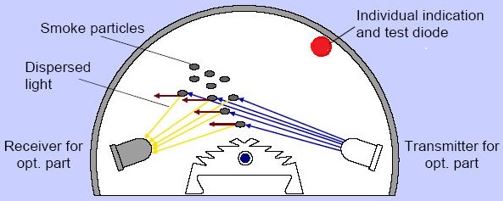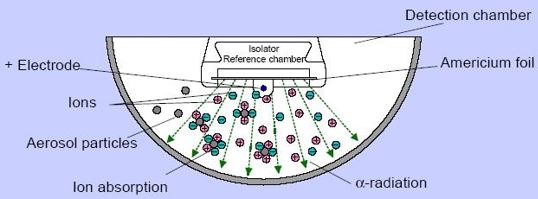Smoke detectors are very popular electronic device which are used to detect the presence of smoke in the surrounding, indicating the possibility of fire. Hence, these are very important in prevention of mishaps due to any fire accident. These devices are present almost in all infrastructures ranging from small restaurants to big buildings and government organisations. By law, every workplace should have a central fire alarm system.
Household smoke alarms are usually mounted in the kitchen and are usually battery-operated. It may not be essentially a fire alarm, but its purpose is only to detect any smoke. However, the control system of the detector can be connected to raise alarm sound and alert the surrounding in case of any fire and hence precautionary measures can be taken in the building or floor to eliminate any serious hazards.
Smoke detectors are generally enclosed within a plastic case and shaped like a disk which is about 6 inches in diameter and 25 millimetres thick.
History of Smoke Detectors
The first heat and smoke detector were patented by George Andrew Darby in 1902 in Birmingham, England. Around twenty years later, a Swiss physicist Dr. Ernst Meli developed a device which had an ionization chamber and was capable of detecting gases in underground mines. He then invented a cold cathode tube which had the capability to amplify the small signal detected by the control system which was strong enough to trigger the alarm. This invention led to the Ionization type Smoke detector. Initially, these ionization type smoke detectors were very costly.
Duane Pearsall who is also considered as the “Father of Smoke Detectors” developed the first practical home Smoke Detector. The replaceable battery in the device made it more cost effective.
Types of Smoke Detectors
- Photoelectric Smoke Detectors
- Ionization Smoke Detectors
- Dual Sensor Smoke Alarm
1. Photoelectric Smoke Detectors
Photoelectric Smoke Detectors have a photoelectric sensor and a light source, which are positioned at 90 degrees to each other. When there is smoke entering through the vents of the smoke detector, it crosses the path of the light beam. Then light is scattered by the smoke particles, which can alert the control system and thus can trigger the alarm. The response time of photoelectric Smoke detectors are much faster than the Ionization type. It can respond in 15 to 50 minutes faster to smouldering fires.

2. Ionization Smoke Detectors
Ionization Smoke Detectors contain a small amount of radioactive material which is positioned between two electrically charged plates. This setup ionizes the air and causes current to flow between these charged plates. When smoke is there it can disrupt the flow of ions between the plates which reduces the flow of current. This change can then trigger the alarm. These types of alarm are highly sensitive to high and raging fires. It can respond to 30 to 90 seconds faster than the photoelectric smoke detectors. However, they do not respond to smouldering fires.

3. Dual Sensor Smoke Alarm
A third type, i.e. the Combination Smoke Detectors use both the above technologies – ionization and Photoelectric. These are more effective in raising an alarm in case of both smouldering type and fast raging fires.
Other types of Smoke Detectors include Auto-aligning optical beam smoke detectors and Heat alarms.
Auto-aligning optical beam smoke detectors can self-align in less than a minute. These are the latest type of smoke detectors which are much more intelligent and efficient. It consists of laser-assisted infrared optical beam smoke detector which are generally employed to protect large commercial and public places like shopping malls, theaters, stadiums with lofty ceilings and condensation issues in their infrastructure.
Heat alarms can detect an increase in the temperature probably caused by the occurrence of fire. They are however unresponsive to smoke. They are usually installed in a garage, kitchen or a dusty room.
Smoke Alarm Research
Some key features and facts that The National Institute of Standards and Technology (NIST) has proposed in their focused research into smoke alarm performance are as follows
- Now, 96% of all houses in the United States have smoke alarms installed.
- Unfortunately, 20% of homes which have installed alarms are not able to use them i.e. they are disabled.
- If every home had a smoke alarm which is functional, residential deaths due to fire could drop by 36% in the United States.
There can be certain guidelines which define the installation procedure of Smoke alarm Detectors. “The Planning and Implementing a Successful Smoke Alarm installation program” is a complete installation guide.
- The choice of Smoke Alarm should be such that it has a label of a certified testing laboratory.
- Smoke alarms in the basement should be installed in the ceiling at the bottom of the stairs which leads to next level.
- In case of domestic alarms in kitchen it should be installed at least 10 feet away from the cooktop to reduce the chances of any false alarm.
- Smoke alarms should always be mounted on a high-rise level to detect the smoke correctly as smoke always rises up.
- Avoid installing smoke alarms near the window, doors or ducts where the operation of the smoke alarms could be interfered.
- Smoke alarms should never be painted. Stickers or any decorations can also hinder the performance of a smoke alarm.
- For best performance all smoke alarms should be interconnected such that if one alarm triggers all the alarms sound. Interconnection can be done wirelessly or it can be wired.
- Interconnected alarms should be compatible i.e. all the alarms should be from the same manufacturer. If they are not compatible all of them might not ring.
- After the Smoke alarms are installed, it should be periodically monitored and tested as per as manufacturer’s guidelines.
- Installed smoke alarms should be checked for low battery and should be changed immediately if the battery gets low.
Interconnected Smoke Alarm Systems improve the safety level to a great extent. Hence one should try to have a system of alarms which are interconnected and all the alarms in this system are interconnected.
Author
Anupama kumari
M.Tech (VLSI Design and Embedded system)
BS Abdur Rahman University
